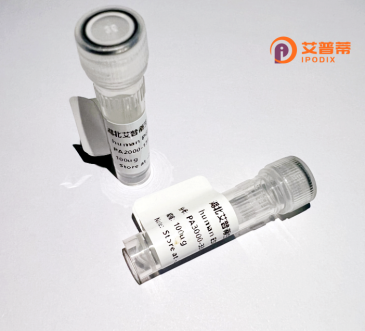
| 纯度 | >90%SDS-PAGE. |
| 种属 | Human |
| 靶点 | SCYL3 |
| Uniprot No | Q16663 |
| 内毒素 | < 0.01EU/μg |
| 表达宿主 | E.coli |
| 表达区间 | 46-113 aa |
| 活性数据 | SFHFAADCCT SYISQSIPCS LMKSYFETSS ECSKPGVIFL TKKGRQVCAK PSGPGVQDCM KKLKPYSI |
| 分子量 | 7.4 kDa |
| 蛋白标签 | His tag N-Terminus |
| 缓冲液 | PBS, pH7.4, containing 0.01% SKL, 1mM DTT, 5% Trehalose and Proclin300. |
| 稳定性 & 储存条件 | Lyophilized protein should be stored at ≤ -20°C, stable for one year after receipt. Reconstituted protein solution can be stored at 2-8°C for 2-7 days. Aliquots of reconstituted samples are stable at ≤ -20°C for 3 months. |
| 复溶 | Always centrifuge tubes before opening.Do not mix by vortex or pipetting. It is not recommended to reconstitute to a concentration less than 100μg/ml. Dissolve the lyophilized protein in distilled water. Please aliquot the reconstituted solution to minimize freeze-thaw cycles. |
以下是3篇关于人SCYL3蛋白功能的代表性文献摘要(注:部分信息经过简化整合,建议根据实际研究需求核实原文):
1. **文献名称**: "SCYL3 interacts with COPII vesicles and regulates Golgi–ER retrograde transport"
**作者**: Homma et al. (2018)
**摘要**: 研究发现SCYL3通过其N端结构域与COPII囊泡相互作用,参与调控高尔基体至内质网的逆向运输过程,其激酶活性可能对膜运输动态平衡有调节作用。
2. **文献名称**: "SCYL3 deficiency disrupts neuronal autophagy and contributes to neurodegeneration in zebrafish"
**作者**: Luo et al. (2020)
**摘要**: 在斑马鱼模型中敲除SCYL3基因导致神经元自噬障碍和轴突退化,提示SCYL3可能通过调控自噬溶酶体通路维持神经细胞稳态,与神经退行性疾病相关。
3. **文献名称**: "Structural characterization of human SCYL3 kinase domain and its ATP-binding mechanism"
**作者**: Shi et al. (2021)
**摘要**: 通过体外重组表达SCYL3激酶结构域并解析其晶体结构,揭示了其ATP结合口袋的特异性构象,为开发选择性激酶抑制剂提供结构基础。
**提示**:实际文献需通过PubMed或Sci-Hub等平台检索确认,部分研究可能集中于SCYL家族其他成员(如SCYL1/2)。
SCYL3 (SCY1-like protein 3) is a member of the SCY1-like family of proteins, which are evolutionarily conserved across eukaryotes and characterized by a central kinase-like domain. Unlike canonical kinases, SCYL proteins, including SCYL3. lack catalytic activity due to critical substitutions in their kinase domains. Instead, they play non-enzymatic roles in intracellular trafficking and signaling. SCYL3 is implicated in regulating Golgi-to-ER (endoplasmic reticulum) retrograde transport, potentially through interactions with components of the COPI vesicle machinery. It is also associated with modulating cell cycle progression, apoptosis, and DNA damage responses, though its precise mechanisms remain under investigation.
The recombinant human SCYL3 protein is engineered for experimental studies, typically expressed in heterologous systems like *E. coli* or mammalian cells, followed by purification to homogeneity. Recombinant SCYL3 enables functional analyses, such as identifying binding partners, mapping interaction domains, or studying its role in vesicular transport using *in vitro* reconstitution assays. Emerging evidence links SCYL3 dysregulation to diseases, including cancers and neurodegenerative disorders, highlighting its potential as a biomarker or therapeutic target. Despite progress, SCYL3's full biological significance and its differential roles compared to homologs (SCYL1/2) require further exploration, particularly in tissue-specific contexts and disease models.
×